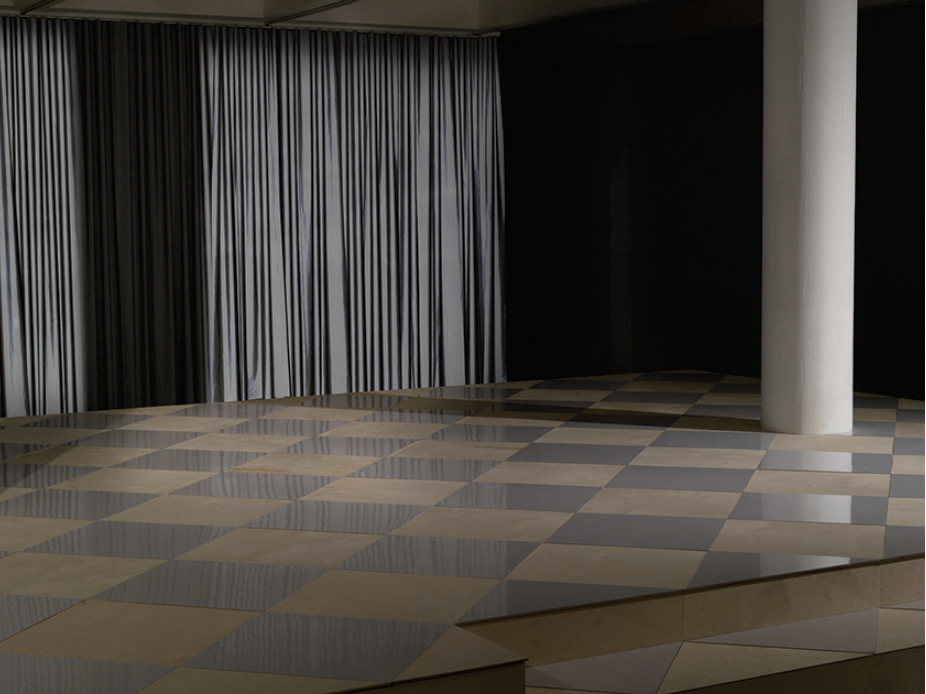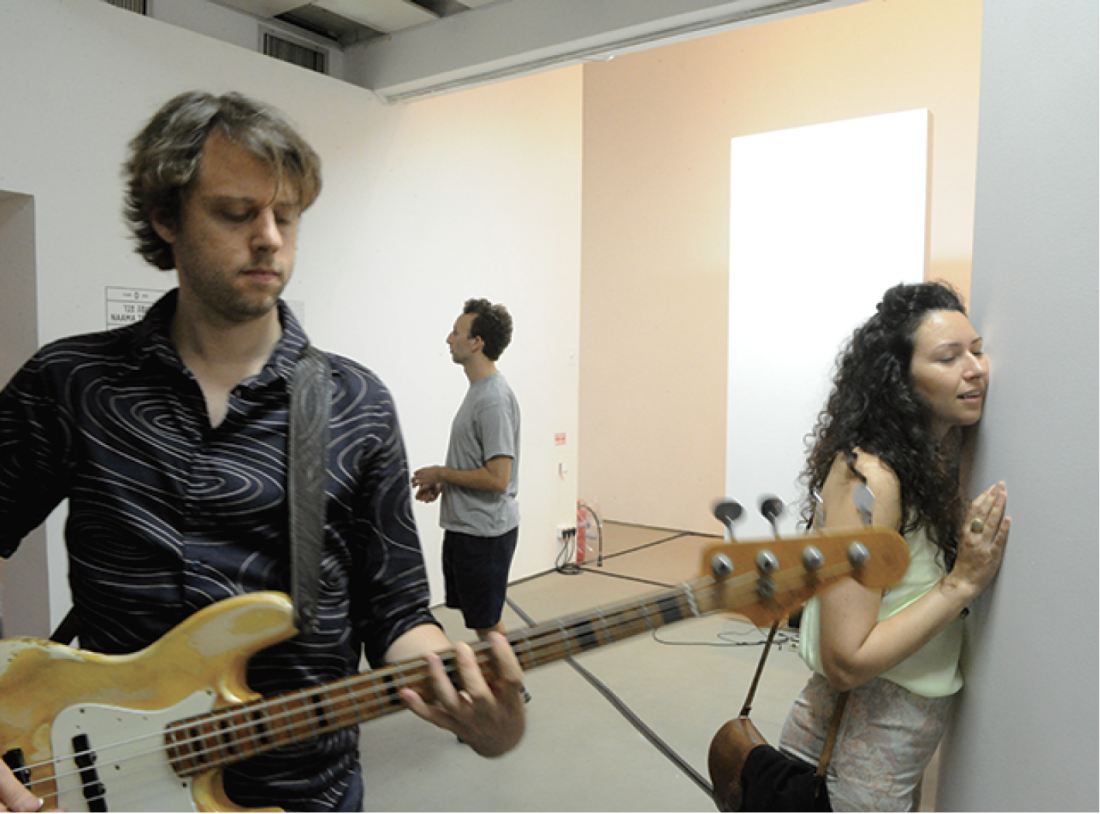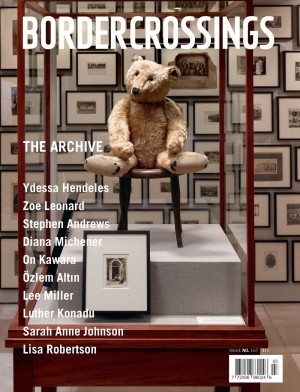“Showtime”
Janet Cardiff, Alona Rodeh, Naama Tsabar

Alona Rodeh, Neither Day Nor Night, 2013, wood, Formica, reflective fabric, lights, sound, dimensions variable, 5 min. looped. Photograph: Oded Lobl.
The Helena Rubinstein Pavilion is situated on the same square in Tel Aviv as the Charles Bronfman Auditorium, which hosts the Philharmonic Orchestra and the Habima Theatre. At the time of its conception in 1952, the idea was to mix the different disciplines of art in a single cultural compound: for the eyes—the fine arts at the Pavilion; for the ears—the music at the concert hall; and spoken words at the theatre.
“Showtime,” curated by Hadas Maor and presented at the Pavilion, proposes three major projects by three artists: the established Canadian artist Janet Cardiff, and the younger Israeli artists Alona Rodeh and Naama Tsabar. The exhibition explores the notion of sound, focusing on its physicality from a sculptural point of view. It also encapsulates the three worlds mentioned in regard to the Pavilion’s location and relating to the term “show”: each project holds references to theatre, music and the plastic arts.

Alona Rodeh, Neither Day Nor Night (detail), 2013, wood, Formica, reflective fabric, lights, sound, dimensions variable, 5 min. looped. Photograph: Oded Lobl.
Janet Cardiff presents The Forty Part Motet, 2001, for the first time in Israel, in the upper gallery of the Pavilion. The work is based on the 16th-century polyphonic piece by Thomas Tallis, Spem In Alium, consisting of 40 harmonies. For her installation Cardiff recorded each voice separately, allowing us to discover them individually or in groups, depending on where we stand in the space. The 40 speakers mounted on stands and reminiscent of actual persons are arranged in a circle and release each of the voices towards the circle’s centre where they all come together. The number of speakers and their display in the space mimics the architectural composition of this complex musical piece, and offers the viewers both a fractured and detailed recording of a choir, which is impressive and powerful in its physicality.
Neither Day Nor Night, 2013, by Alona Rodeh was conceived especially for the Pavilion’s lower level. The darkened large room is filled, in its centre, by a prominent wooden stage punctuated by two white columns. The stage is decorated with diamond-shaped formica pieces, forming a checkered-pattern surface. Behind it hangs a long curtain, which reinforces the theatrical setting of the installation. The curtain, made of a reflective fabric, sways slightly from time to time and changes colours in the palette of reds, blues and whites. The expression “performance without performers” has been used to describe many of Rodeh’s previous works and in Neither Day Nor Night this is again pertinent. The curtain seems to have its own life and the empty stage hints at the presence of performers. The only real performers are the visitors themselves, who are part of this installation and are invited to observe it, to experiment with it, to listen to it, to meditate through it—to perform. The music, which emerges from the amplifiers incorporated within the stage itself, is a variation on Erik Satie’s renown Gymnopédie No. 1, 1888, originally written for piano. It has been produced by Kalbata (Ariel Tagar) and interpreted by Yuval (Tuvi) Zolotov on a tuba. Furthermore, the piece has been stretched and the sound is deep and low, creating an over-dramatic and mysterious atmosphere, perfectly fitting to the lower space Rodeh was offered. Her installation’s strength is in allowing a mystical disconnection from the exterior world. It functions as an autonomous entity, offering a solemn escape from our own days and nights.

Janet Cardiff, The Forty Part Motet (a reworking of “Spem in Alium” by Thomas Tallis, 1573), 2001, 40 loudspeakers mounted on stands, amplifiers, playback computer, 14 min. loop with 11 min. of music and 3 min. of intermission. Photograph: Oded Lobl.

Naama Tsabar, Propagation (Opus 2), 2013, mixed media installation with walls, columns, guitar/bass amplifiers, stage monitors, stage lights, microphones, dollies, beer crates. Photograph: Oded Lobl.
Naama Tsabar’s Propagation (Opus 2) is also a site-specific installation and welcomes the visitors at the pavilion’s entrance level. The space’s walls are painted white and inclined at different angles. At the base of each wall are amplifiers, speakers and mixers, some of which are connected to microphones, others are supported by either a dolly or beer crates. Along the walls, Tsabar has also placed two columns which are each topped by a projector, pouring light inside the hollow column, light which is never released to the exhibition space. The impression upon entering the space is, on one hand, abundance, with the different walls and columns dotting the room, but on the other hand, with the striking white of the architectural elements, a feeling of purity and spareness, recalling a Zen garden. The installation is versatile and has three different “lives.” The work can be approached as an evocative stand-alone piece. The visitors have again, as in Cardiff’s and Rodeh’s work, an important role: they can choose to observe and let the installation function by itself or become performers. They can, for example, discover the walls’ special effects on the sound released by opening the microphones and singing into the walls. At the vernissage of “Showtime,” Tsabar’s work took yet another form when she performed Propagation (Opus 2), a cover version of Bruce Nauman’s Body Pressure from 1974, together with musicians who were scattered around the room. This performance of Tsabar’s work was then followed by weekly live performances featuring up-and-coming artists in the Israeli music scene. It was then that the installation took its strongest form, experimental and open to the performers and audience and, at the same time, self-contained.
“Showtime” is the expression used to describe the moment preceding a show, it is a moment of suspension, full of promises and possibilities. This suspension is palpable in each of the projects presented at the pavilion, creating a feeling of constant expectation and tension and offering a fertile ground for exploration. Through the artists’ original use of sound and reinterpretations of the word “Show”—through music, performances or theatrical staging, and through the excellent curation of the three spaces, the exhibition allows and urges the visitors to fill the voids and silent pauses.
“Showtime” was exhibited at the Helena Rubinstein Pavilion, Tel Aviv Museum of Art, Israel, from August 2 to November 23, 2013.
Sarah Peguine is the founder of “Oh-So-Arty,” a platform offering a guide to the Israeli contemporary art scene (<www.ohsoarty.com>). She is based in Tel Aviv (<www.facebook.com/telavivgalleries>).

Naama Tsabar, Propagation (Opus 2), 2013, mixed media installation with walls, columns, guitar/bass amplifiers, stage monitors, stage lights, microphones, dollies, beer crates. Photograph: Oded Lobl.

